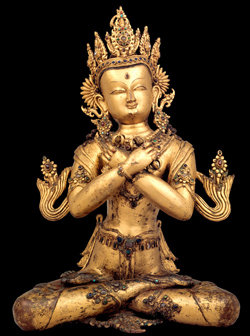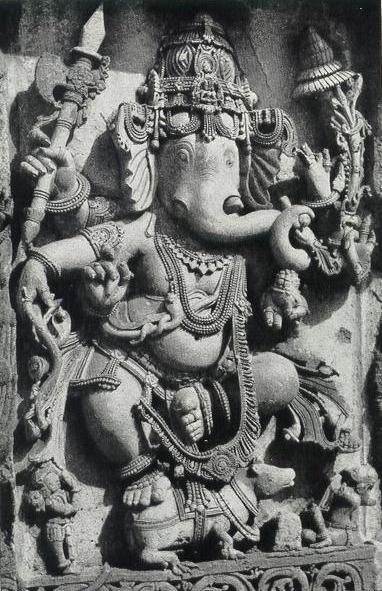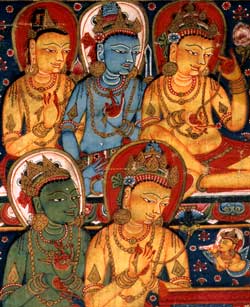
Terresa M. Fagan |
 |
 |
 |
| HOME |
| Resources |
| Lesson 4 Finding Global Connections Through Art |
| Lesson 7 Sacred Circles |
LESSON THREE - Taking a Closer Look
OBJECTIVE: Studens will learn to complete the process of art criticism using four domains:
DESCRIBE, ANALYZE, INTERPRET, JUDGE.
Expect to spend at least three days on this lesson.
*Day one - Teacher explains and models lesson. Students research/find a selection of art to critique.
*Day two - Students complete the critique process as outlined below and write their critiques.
*Day three - Students present artwork and critiques to the class.
Use the Resources page to find a link to make a selection of artwork.
DESCRIPTION
Take the time to look at the artwork. In this step you are an art "detective." You are gathering factual evidence or clues. During this step you must be objective. In other words, give only the facts: artist, title, size, medium, collection, etc. You must say what you actually observe. Do not make guesses about what you see. If you see figures and you can't tell whether they are male or female, simply list them as people.
Description Questions
1. Name all the recognizable objects that you see.
2. What is the name of the artwork?
3. What is the date of the artwork?
4. What is the size and medium of the artwork?
5. Who is the artist of the artwork?
6. What are all the shapes that are in the artwork?
7. What are the types of lines that are in the artwork?
8. What types of patterns and textures are in the artwork?
9. What are the colors that are in the artwork?
ANALYSIS
During the analysis stage you are still collecting the facts. Pay attention to how the work of art is organized, including the elements of art and the principles of design. You will study how the artist has used each element and principle. Explain the artists approach to utilizing ideas, themes and concepts in the artwork. For example, notice the shape of the images in the artwork. List each way the elements of art were used to convey the artists' intention. List how the principles of design were used to convey rhythm, movement, balance, proportion, variety, emphasis, and unity.
1. What are all the elements and principles of design you can see in this artwork?
2. How are the shapes arranged in the artwork? (symmetrical, triangular, vertical, etc.)
3. How is the space arranged in the artwork? (flat, shallow depth, deep depth, etc.)
4. How is the medium used in the artwork? (small stokes, smooth finish, well blended, roughly carved, etc.)
INTERPRETATION
During this step you have two questions to answer. "What is happening?" and "What is the artist trying to say?" You will interpret (explain or tell the meaning to support your understanding of the artist's intention.) It is here that you can make guesses. Interpretation is the most difficult art criticism step for some people. But it can also be the most creative and the most rewarding. You must use your group's intelligence, imagination, and courage to make appropriate guesses. You must not be afraid to make an interpretation that is different from anyone else's. After all, you are different from anyone else. Your ideas must be backed up by observation.
Interpretation Questions
1. What is the meaning of the artwork?
2. How does the artwork make you feel?
3. What types of symbolism do you see?
4. What does this artwork mean to you?
5. What makes this artwork important?
6. How do you think the artist feels about the subject that he/she created?
JUDGMENT
In this step you will judge whether or not the artwork succeeds or fails. This is the time to express your own opinion. Reflect upon the social, cultural, psychological and environmental influences upon the work of art. You need to know why you feel the way you do.
Judgment Questions
1. What do you think of the artwork?
2. What do you think the artist was communicating?
Imitative: the artist tried to accurately describe the subject matter: people, events, objects.
Formalism: the artist tried to experiment with art elements and principles of design, (line, shape, color, texture, patters, form, variety, unity, etc.)
Emotionalism: The artist emphasized moods or symbols.
Functionalism: The artist intended the artwork to be useful, religious, educational, or propaganda.
Choose one of the above theories for judging art and explain in paragraph form reasons why you selected the one you did.
3. Who would appreciate this type of artwork and why? (mothers, elderly, religious people, teenagers, etc.)
4. After considering your answers, what is your opinion of the artwork?
Upon completing the investigation of each of the above four domains, write a formal critique of your art selection.
Present your art selection and your critique of it to the class.